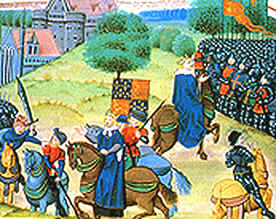Medieval England experienced few revolts but the most serious was the Peasants’ Revolt which took place in June 1381. A violent system of punishments for offenders was usually enough to put off peasants from causing trouble. Most areas in England also had castles in which soldiers were garrisoned, and these were usually enough to guarantee reasonable behaviour among medieval peasants.
An army of peasants from Kent and Essex marched on London. They did something no-one had done before or since – they captured the Tower of London. The Archbishop of Canterbury and the King’s Treasurer were killed. The king, Richard II, was only 14 at the time but despite his youth, he agreed to meet the peasants at a place called Mile End.
What were the peasants angry about and why had they come to London ?
1. After the Black Death, many manors were left short of workers. To encourage those who had survived to stay on their manor, many lords had given the peasants on their estates their freedom and paid them to work on their land. Now, nearly 35 years after the Black Death, many peasants feared that the lords would take back these privileges and they were prepared to fight for them.
2. Many peasants had to work for free on church land, sometimes up to two days in the week. This meant that they could not work on their own land which made it difficult to grow enough food for their families. Peasants wanted to be free of this burden that made the church rich but them poor. They were supported in what they wanted by a priest called John Ball from Kent.
3. There had been a long war with France. Wars cost money and that money usually came from the peasants through the taxes that they paid. In 1380, Richard II introduced a new tax called the Poll Tax. This made everyone who was on the tax register pay 5p. It was the third time in four years that such a tax had been used. By 1381, the peasants had had enough. 5p to them was a great deal of money. If they could not pay in cash, they could pay in kind, such as seeds, tools etc., anything that could be vital to survival in the coming year.
In May 1381, a tax collector arrived at the Essex village of Fobbing to find out why the people there had not paid their poll tax. He was thrown out by the villagers. In June, soldiers arrived to establish law and order. They too were thrown out as the villagers of Fobbing had now organised themselves and many other local villages in Essex had joined them. After doing this, the villagers marched on London to plead with the young king to hear their complaints.
One man had emerged as the leader of the peasants – Wat Tyler from Kent. As the peasants from Kent had marched to London, they had destroyed tax records and tax registers. The buildings which housed government records were burned down. They got into the city of London because the people there had opened the gates to them.
By mid-June the discipline of the peasants was starting to go. Many got drunk in London and looting took place. It is known that foreigners were murdered by the peasants. Wat Tyler had asked for discipline amongst those who looked up to him as their leader. He did not get it.
On June 14th, the king met the rebels at Mile End. At this meeting, Richard II gave the peasants all that they asked for and asked that they go home in peace. Some did. Others returned to the city and murdered the archbishop and Treasurer – their heads were cut off on Tower Hill by the Tower of London. Richard II spent the night in hiding in fear of his life.
On June 15th, he met the rebels again at Smithfield outside of the city’s walls. It is said that this was the idea of the Lord Mayor (Sir William Walworthe) who wanted to get the rebels out of the city. Medieval London was wooden and the streets were cramped. Any attempt to put down the rebels in the city could have ended in a fire or the rebels would have found it easy to vanish into the city once they knew that soldiers were after them.
At this meeting, the Lord Mayor killed Wat Tyler. We are not sure what happened at this meeting as the only people who could write about it were on the side of the king and their evidence might not be accurate. The death of Tyler and another promise by Richard to give the peasants what they asked for, was enough to send them home.

Walworth, bottom left hand corner, killing Tyler. Richard II is just behind Tyler and also addressing the peasants after Tyler’s death
By the summer of 1381, the revolt was over. John Ball was hanged. Richard did not keep any of his promises claiming that they were made under threat and were therefore not valid in law. Other leaders from both Kent and Essex were hanged. The poll tax was withdrawn but the peasants were forced back into their old way of life – under the control of the lord of the manor.
However, the lords did not have it their own way. The Black Death had caused a shortage of labour and over the next 100 years many peasants found that they could earn more (by their standards) as the lords needed a harvest in and the only people who could do it were the peasants. They asked for more money and the lords had to give it.
![]()